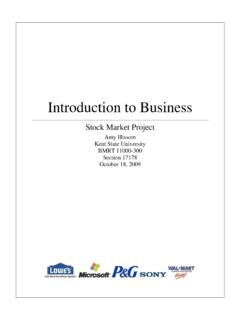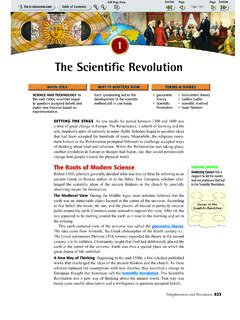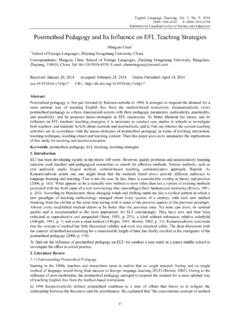Transcription of Management - Amy Hissom
1 Management Introduction to Management Technology BMRT 11009 - Section 300 Kent State University AMY Hissom 10/26/2009 2 TABLE OF CONTENTS Introduction .. 3 Managers and Managing .. 4 What is Management ? .. 4 Essential Managerial Tasks .. 4 Levels and Skills of Managers .. 4 Recent Changes in Management Practices .. 5 Challenges for Management in a Global Environment .. 5 The Evolution of Management Thought .. 6 F. W. Taylor (1890-1940): Scientific Management .. 6 The Gilbreths: Time-and-Motion study .. 6 Max Weber (1864-1920): The Theory of 7 Henri Fayol (1841-1925): Principles of Management .. 8 The Work of Mary Parker Follett .. 8 The Hawthorne Studies .. 9 Douglas McGregor: Theory X and Theory Y.
2 10 The Open-Systems View .. 10 Contingency Theory .. 11 Values, Attitudes, Emotions, and Culture: The Manager as a Person .. 12 Enduring Characteristics: The Big Five Personality Traits .. 12 Values, Attitudes, Moods, and Emotions .. 13 Summary .. 15 Bibliography .. 16 3 INTRODUCTION The purpose of this paper is to give a basic understanding of managers and managing. It is a compilation of resources that explain what Management is, the different levels of Management , and what tasks are essential for managers. It also includes recent changes in Management practices along with and explanation of challenges for Management in a global environment. Throughout this paper you will gain a basic understanding of the evolution of Management thought and the different theories involving Management .
3 Although we all have our own values, attitudes, moods, and emotions, so do managers. The last part of this paper gives a basic view of how these affect the manager. The Four Tasks of Management Notice that the last word in every circle is "goals". PlanningChoose appropriate organizational goals and courses of action to best achieve those task and authority relationships that allow people to work together to achieve organizational , coordinate, and energize individuals and groups to work together to achieve organizational accurate measuring and monitoring systems to evaluate how well the organization has achieved its MANAGERS AND MANAGING What is Management ? " Management is the organizational process that includes strategic planning, setting objectives, managing resources, deploying the human and financial assets needed to achieve objectives, and measuring results.
4 Management also includes recording and storing facts and information for later use or for others within the organization. Management functions are not limited to managers and supervisors. Every member of the organization has some Management and reporting functions as part of their job." (Knowledge Management Terms, 2009) Essential Managerial Tasks A manager's job uniquely describes the functions of Management , which are most commonly cited as planning, organizing, leading, and controlling, although some managers' jobs identify additional functions. The process of Management is defined by the functions of Management , which are distinct from accounting, finance, marketing, and other business functions.
5 " These functions provide a useful way of classifying information about Management , and most basic Management texts since the 1950s have been organized around a functional framework." (Cengage, 2006) Levels and Skills of Managers Most organizations have three levels of Management . First-line, middle, and top managers. While first-line managers are responsible for the day-to-day supervision of non-managerial employees, middle managers are responsible for developing and utilizing organizational resources efficiently and effectively, and top managers have cross departmental responsibility. 5 There are three main kinds of managerial skills which include conceptual, human, and technical.
6 Organizations divide managers into departments according to their job responsibilities because of the need to develop and build technical skills. "Top managers must establish appropriate goals for the entire organization and verify that department managers are utilizing resources to achieve those goals." (George, 2009, p. 31) Recent Changes in Management Practices Many organizations have changed the way they operate so that they can increase efficiency and effectiveness. To reduce costs, managers have restructured and downsized operations and outsourced activities. To increase efficiency and effectiveness, organizations are also utilizing self-managed teams and empowering their workforces. "Managers are increasingly utilizing IT to achieve these objectives.
7 " (George, 2009, p. 31) Challenges for Management in a Global Environment It can take years to build an internationally competent workforce whose members know the business and are flexible and open-minded. Organizations that are multinational can no longer rely on just a few experts of a particular country or a few managers with multicultural experience to succeed. For this reason, all employees must have some minimal level of international expertise and be able to recognize cultural differences that may affect working relationships and daily business communications. Overseas managers share common traits with their domestic counterparts. "Wherever a manager is hired, he or she needs the technical knowledge and skills to do the job, and the intelligence and people skills to be a successful manager.
8 Selecting managers for expatriate assignments means screening them for traits that 6 predict success in adapting to what may be dramatically new environments." (Personal Challenges for Global Managers, 2009) THE EVOLUTION OF Management THOUGHT F. W. Taylor (1890-1940): Scientific Management At the turn of the century, the most notable organizations were large and industrialized and often included ongoing, routine tasks that manufactured a variety of products. "The United States highly prized scientific and technical matters, including careful measurement and specification of activities and results. Management tended to be the same. Frederick Taylor developed the "scientific Management theory which espoused this careful specification and measurement of all organizational tasks.
9 Tasks were standardized as much as possible. Workers were rewarded and punished. This approach appeared to work well for organizations with assembly lines and other mechanistic, routinized activities." (Carter McNamara, 2009) F. W. Taylor was considered the "father of Management thought." He developed four principles to increase efficiency in the workplace based on his own experience and observations as a manufacturing manager. (George, 2009, p. 43) The Gilbreths: Time-and-Motion study Frank and Lillian Gilbreth refined time-and-motion study in the early twentieth century. "The Gilbreths' preferred "motion study " to Taylor's "time study ," however the term "Time and Motion" has tended to stick in popular terminology.
10 The Gilbreths studied the actions taken by workers at certain task with the aim of streamlining the processes involved. One of their most famous experiments involved analyzing the work of bricklayers and significantly reducing the 7 number of "operations" involved. This change benefited both employer (increased productivity) and employee (decreased fatigue). The Gilbreths developed a categorization system for the different basic activities which went to make up a task. These were called Therbligs (an anagram of "Gilbreths"). The basic Therbligs numbered around 15 (the system developed over time) and included such actions as "find", "select" and "rest." Each of these was represented by an icon, for example an eye for "find.




